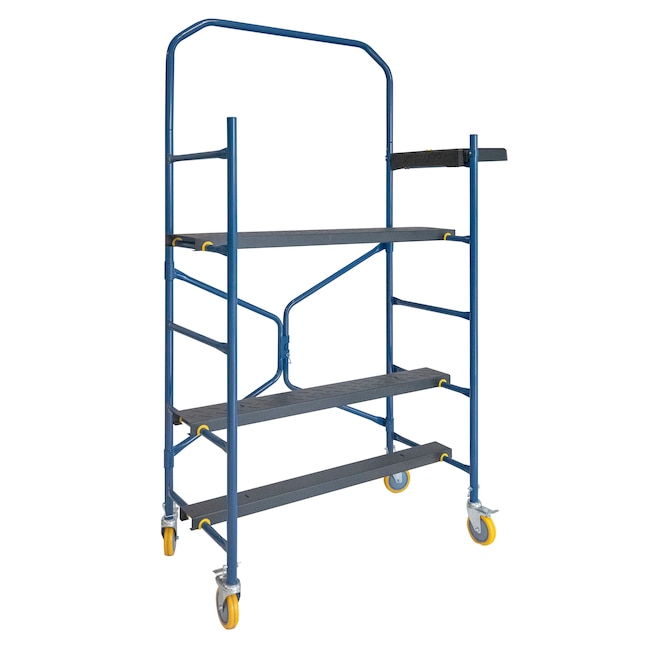Residential Scaffolding Solutions for Safe and Efficient Home Improvements
Residential Scaffolding Solutions for Safe and Efficient Home Improvements
Blog Article
Exploring the Various Sorts Of Scaffolding Used in Building Projects
The building market counts greatly on various types of scaffolding to satisfy certain task requirements, each offering distinct advantages and applications. Standard structure scaffolding provides a sturdy foundation for general tasks, while suspended scaffolding is necessary for job on skyscraper frameworks.

Conventional Frame Scaffolding
Typical framework scaffolding is one of the most commonly used techniques in the building and construction market as a result of its toughness and versatility. This system contains upright and horizontal frameworks that are assembled to develop a steady system for workers and products. The primary components include vertical posts, straight journals, and diagonal dental braces, which together give a solid framework that can support considerable loads.
One of the essential benefits of traditional framework scaffolding is its flexibility to various building jobs, varying from residential buildings to big industrial frameworks. The modular layout permits simple setting up and disassembly, making it reliable for both temporary and lasting projects. Furthermore, the system can be tailored in height and size, suiting various structure styles and site conditions.
Security is vital in scaffolding applications, and typical frame systems are equipped with guardrails and toe boards to stop falls and make certain worker security. Regular inspections and adherence to safety and security regulations are crucial in maintaining the integrity of the scaffold (Scaffolding). Overall, typical structure scaffolding continues to be a basic selection in the building and construction sector, supplying a reliable system for labor and boosting general job effectiveness

Suspended Scaffolding
Put on hold scaffolding supplies a distinct remedy for building tasks that need access to elevated surface areas, particularly in scenarios where conventional structure scaffolding may be unwise. This kind of scaffolding is normally suspended from the roofing or upper levels of a framework, utilizing a system of sheaves, systems, and ropes to create a working room that can be gotten used to different elevations.
Among the primary advantages of put on hold scaffolding is its adaptability. It can be easily repositioned or reduced to accommodate adjustments in construction needs, making it suitable for jobs such as window installation, façade job, and upkeep on skyscraper buildings. Additionally, the very little impact of put on hold scaffolding permits far better use ground space in urban environments, where room is usually limited.
Safety is an important factor to consider in using put on hold scaffolding. Correct rigging and securing systems have to be used to make certain security and protect against crashes. Operators has to additionally be learnt the secure usage of this tools. On the whole, put on hold scaffolding supplies a effective and efficient service for accessing hard-to-reach locations in different building scenarios, enhancing both productivity and safety and security on website.
System Scaffolding
System scaffolding, scaffolder competence frequently considered as a modern-day option in the scaffolding industry, is composed of pre-engineered elements that can be quickly set up and adapted for numerous building tasks. Scaffolding. This sort of scaffolding is characterized by its modular layout, which enables convenience and performance on task websites, suiting different elevations and structural needs
Typically made from high-strength steel or light weight aluminum, system scaffolding offers improved resilience and security. The parts include upright posts, horizontal journals, and diagonal dental braces, which adjoin securely, making certain a robust structure. The style usually incorporates standard fittings, simplifying assembly and disassembly processes, thus minimizing labor time and expenses.

Rolling Scaffolding
Rolling scaffolding is a versatile option to conventional fixed scaffolding, made for wheelchair and ease of usage on building sites. This kind of scaffolding contains a system supported by frames with wheels, permitting workers to conveniently move it as needed. The wheelchair feature dramatically improves productivity, as it decreases downtime related to setting up and dismantling repaired scaffolding.
Normally built from light-weight materials such as light weight aluminum or steel, rolling scaffolding supplies a strong yet portable service for tasks needing constant repositioning - Scaffolding. It is particularly helpful in jobs such as painting, drywall installment, and electric work, where accessibility to various heights and areas is necessary
Security is extremely important in rolling scaffolding design, with functions such as securing wheels to avoid unexpected activity when in use, and guardrails to secure employees from falls. Additionally, lots of versions are flexible in click to read elevation, accommodating various job demands.
Cantilever Scaffolding

The layout of cantilever scaffolding commonly includes using braces or arms secured to a building or structure, enabling the system to extend exterior safely. Safety and security is vital; thus, these scaffolds have to be engineered to hold up against different loads and ecological problems. Regular assessment and maintenance are necessary to guarantee architectural integrity and worker safety and security.
Cantilever scaffolding is favored for its convenience and efficient usage of space, making it a prominent selection in urban atmospheres where room constraints prevail. Moreover, it resource helps with simpler accessibility to high altitudes, ultimately adding to the total efficiency of building tasks. As with all scaffolding types, appropriate training and adherence to safety and security standards are crucial for employees making use of cantilever scaffolding.
Final Thought
Conventional frame scaffolding provides security, while put on hold scaffolding provides versatility for raised jobs. System scaffolding assists in quick setting up, and rolling scaffolding enhances flexibility for differing work settings.
Standard framework scaffolding provides a tough foundation for general jobs, while suspended scaffolding is essential for job on high-rise frameworks.Rolling scaffolding is a functional option to traditional set scaffolding, developed for flexibility and simplicity of use on building and construction sites. As with all scaffolding kinds, correct training and adherence to safety and security standards are crucial for employees making use of cantilever scaffolding.
Conventional frame scaffolding supplies stability, while suspended scaffolding uses versatility for raised tasks. System scaffolding assists in quick assembly, and rolling scaffolding boosts movement for differing work atmospheres.
Report this page